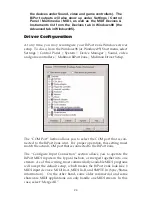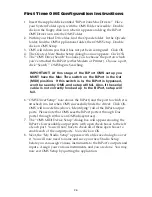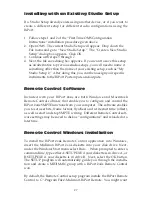
BiPort 2x4s INSTALLATION
Installation for Stand-Alone Mode
A typical stand-alone system set-up (see Fig. 1) might consist of a BiPort
2x4s, a tape deck, and a hardware MIDI sequencer. This set-up is con-
nected as follows:
• The tape recorder Tape (or Sync) Out is connected to the BiPort 2x4s
SMPTE In.
• The tape recorder Tape (or Sync) In is connected to the BiPort 2x4s
SMPTE Out.
• The BiPort 2x4s MIDI Out-A is connected to the MTC (or MIDI) In of
the MIDI sequencer.
In this example, the BiPort 2x4s serves several functions: 1) it synchro-
nizes the MIDI hardware sequencer to the tape recorder by converting
the tape recorder’s SMPTE signal into MIDI Time Code for use by the
sequencer; 2) it acts as a stand-alone SMPTE striper for writing a SMPTE
track to the tape recorder. The BiPort 2x4s’ front panel pushbuttons are
used to manually configure and control the BiPort.
Before connecting each piece of equipment, it is a good idea to verify
that each piece is powered down. After all connections are made, apply
power to each device once again.
Installation for MIDI Interface Mode
A typical MIDI interface system set-up (see Fig. 2) consists of a BiPort
2x4s, a host computer, your sequencing software, a tape deck, a master
MIDI keyboard, and additional MIDI sound modules or keyboards.
This set-up is connected as follows:
• The BiPort 2x4s Host In is connected to the serial port of a host com-
puter, using one of the supplied serial cables. See following sections
for more information.
• The BiPort 2x4s Mac Thru button is latched in the “out” position so
that the BiPort 2x4s may communicate with the host computer.
• BiPort 2x4s MIDI In-A is connected to MIDI Out of your MIDI master
keyboard.
• BiPort 2x4s MIDI Out-A is connected to MIDI In of your MIDI master
keyboard.
• The tape deck Tape Out (or Sync Out) is connected to the BiPort 2x4s
13













































